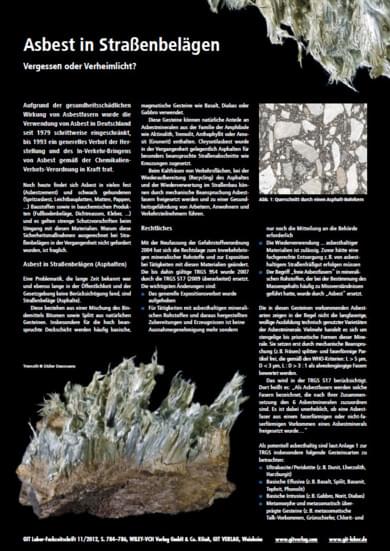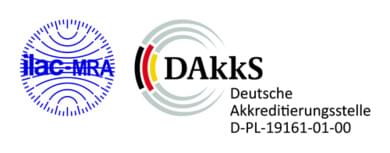This small article was the basis of two publications in the GIT Labor-Fachzeitschrift 11/2012 (in German) and the Mitteilungen des Berufsverbands Deutscher Geowissenschaftler, BDG, 120, Ausgabe 01/13 as well as the basis for a Wikipedia article entitled "Asbest in Asphaltfahrbahnbelägen" (in German) which has been revised many times in the meantime.
Download of the article as pdf-file:asbest-in-asphalt-fachartikel-crb-analyse-gmbh.pdf (in German)
Asbestos in road surfaces
Introductory remarks
Due to the harmful effects of asbestos fibres on health, the use of asbestos in Germany has been gradually restricted since 1979, until 1993 when a general ban on the manufacture and marketing of asbestos came into force under the Chemicals Prohibition Regulation.
Asbestos is still found today in many solid (asbestos cement) and weakly bonded (sprayed asbestos, lightweight boards, mats, cardboard, ...) building materials as well as in construction chemical products (floor coverings, sealants, adhesives, ...) and strict protective regulations apply when handling these materials.
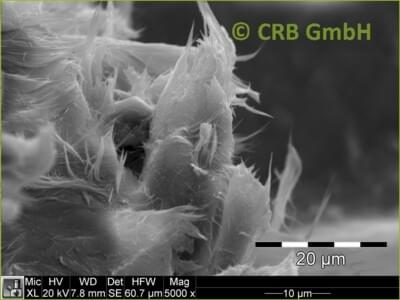 Asbestos in road surfaces (asphalt) - problems
Asbestos in road surfaces (asphalt) - problems
Road surfaces (asphalt) are a problem that has been known for a long time and has not been taken into account by the public or by legislation for just as long.
These consist of a mixture of bitumen binder and natural stone chippings. Basic, magmatic rocks such as basalt, diabase or gabbro are frequently used for the highly stressed surface course in particular.
These rocks may contain natural parts of asbestos minerals from the amphibole family such as actinolite, tremolite, anthophyllite or amosite (Grunerite). In the past, chrysotile asbestos was occasionally added to asphalts for road sections subject to heavy traffic, such as crossings.
Asbestos fibres can be released during cold milling of traffic areas, during recycling of asphalt and during road construction and can lead to health hazards for workers, residents and road users.
Legal aspects
With the revision of the Hazardous Substances Ordinance in 2004, the legal situation regarding the placing on the market of mineral raw materials and exposure during activities involving these materials has changed. The previously valid TRGS 954 was replaced in 2007 by TRGS 517 (revised 2009). The most important changes are:
- The general ban on exposure was lifted
- Activities involving mineral raw materials containing asbestos and preparations and articles derived therefrom will no longer require a derogation but only notification to the Authority.
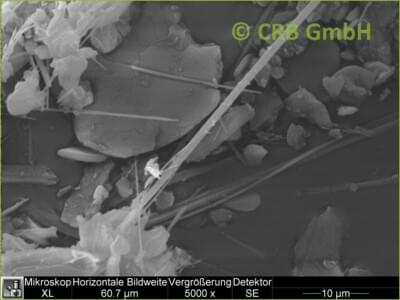
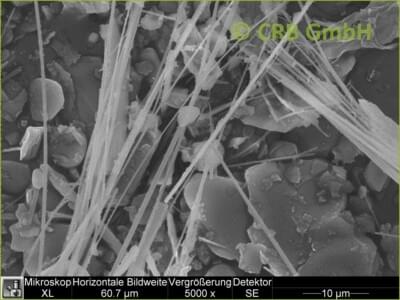
- The reuse ... materials containing asbestos is permissible. Before this, a professional disposal of e.g. road milled material containing asbestos would have been necessary
- The term 'free asbestos fibres' in mineral raw materials, which had often given rise to misunderstandings when determining the mass content, was replaced by 'asbestos
The types of asbestos found in these rocks generally do not show the long-fibred, woolly formation of technically used varieties of asbestos minerals. Rather, they are stem-shaped to prismatic forms of these minerals. They only release splinter- and fibrous particles through mechanical stress (e.g. milling), which are classified according to the WHO criteria: L > 5µm, D < 3µm, L : D > 3 : 1 are evaluated as alveolar fibres.
This is considered in TRGS 517. There it says: 'Asbestos fibres are those fibres which are classified as 6 asbestos minerals according to their composition. It is irrelevant whether an asbestos fibre was released from a fibrous or non-fibrous occurrence of an asbestos mineral...'.
According to Annex 1 to the TRGS, the following types of rock in particular are to be regarded as potentially containing asbestos:
- Ultrabasite/peridotites (e.g. dunite, lherzolite, harzburgite)
- Basic effusiva (e.g. basalt, spilit, basanite, tephrite, phonolite)
- Basic intrusives (e.g., gabbro, norite, diabase)
- Metamorphic and metasomatically overstamped rocks (e.g. metasomatic talc deposits, green slate, chlorite and amphibolic slates/rock (e.g. nephrite), serpentinite, amphibolite)
According to TRGS 517
- ... the employer shall assume that no asbestos is present during the extraction, processing, re-processing, further processing and recycling of mineral raw materials from rocks not listed in Appendix 1.
Furthermore, according to TRGS 517 No. 1 Par. 4, the legislator states that
- ... The employer can assume that the mass content of asbestos in mineral raw materials, such as those found in quarries in the Federal Republic of Germany, for example, is less than 0.1 per cent, so that the ban on manufacture and use in accordance with § 18 in conjunction with § 18 of the German Chemicals Ordinance is not applicable. Annex IV No. 1 para. 2 subpara. 3 Hazardous Substances Ordinance is not affected.
This assumption is wrong! Numerous investigations of the chippings fractions of asphalts have shown that WHO fibre concentrations >0.1 %, total fibre concentrations >0.5 % and total asbestos contents (fibrous and non-fibrous particles) in the range of several percentage points can occur in places, especially in gabbros and norites.
 Method of investigation
Method of investigation
The content of respirable asbestos (WHO) fibres must be determined in chippings from rocks classified as potentially containing asbestos in accordance with TRGS 517.
This is done according to procedure 4, annex 2 of TRGS 517:
- Determination of the mass content of asbestos in compact materials (e.g. pieces of soapstone, natural stone), the use of which may give rise to inhalable dusts (e.g. by drilling, sawing, milling, grinding)
according to the IFA / BIA procedure 7487:
- Method for the analytical determination of low mass contents of asbestos fibres in powders, powders and dusts using SEM/EDX (index 7487). In: IFA / BIA workbook Measurement of hazardous substances. 18th Lfg. IV/97th ed.: Berufsgenossenschaftliches Institut für Arbeitsschutz, Sankt Augustin. Erich Schmidt, Bielefeld 1989 - Loose-leaf edition
In this complex process, the asphalt samples, most of which are in the form of drill cores, are broken and homogenised, and the bitumen/tar content is extracted by annealing or dissolving. The material is then ground to grain sizes < 100 µm and a partial quantity of the sample powder is converted into distilled water. Water suspended. The water is filtered and the filter is examined by scanning electron microscopy / X-ray microanalysis.
With a high detection sensitivity of 0.008%, low asbestos contents can be determined.
If the (WHO) asbestos fibre concentration is > 0.008 %, appropriate protective measures must be taken when handling the material. If the total asbestos fibre concentration is > 0.1 %, the use of the material is prohibited by the GefStoffV and the material must be disposed of.
Conclusion
The way this problem is dealt with varies from one federal state to another. At present only in Lower Saxony, partly also in Hamburg and Schleswig Holstein, is asphalt tested according to TRGS 517 / IFA / BIA 7487. In other federal states (e.g. NRW), it is generally assumed that asphalt may contain asbestos and protective measures are taken, e.g. when milling traffic areas (extraction, hot and wet milling). There is no information available from most federal states on the handling of TRGS 517 in road construction.
There is certainly a need for action to standardize the implementation of the valid legal requirements nationwide. The question also arises as to whether it makes sense to continue mining rocks, such as gabbros, whose hazard potential is sufficiently known, and to process them into chippings. And what about the railway's track network, in which the track beds are predominantly 'ballasted' with basalt?


